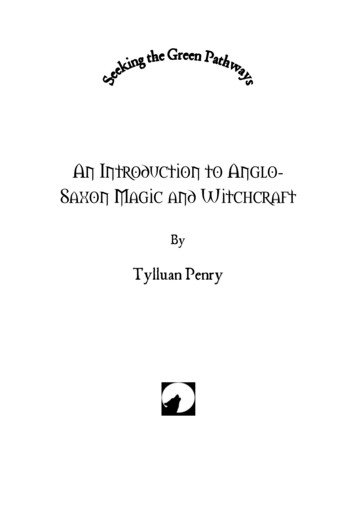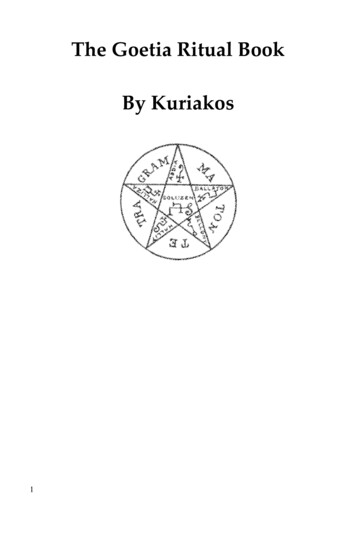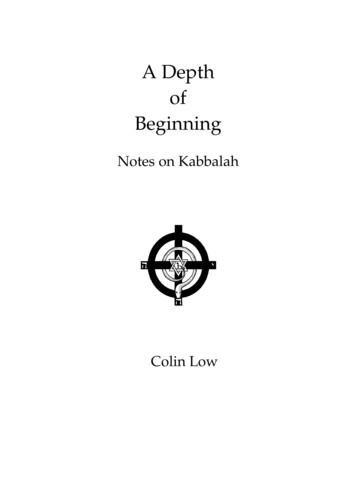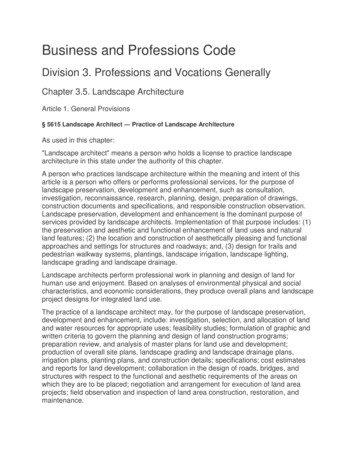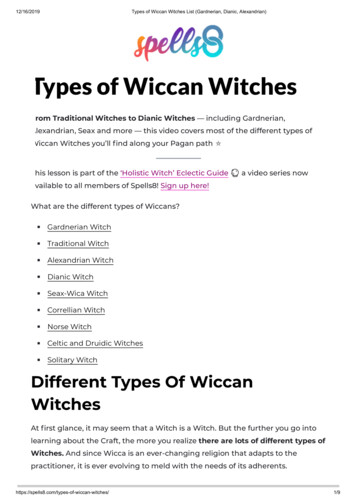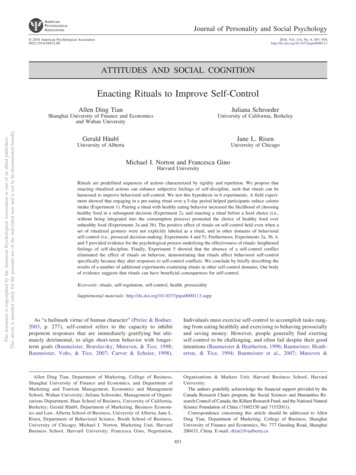
Transcription
Mapping the Wiccan Ritual Landscape:Circles of TransformationNikki Bado- FrcrlickWicca, or Witchcraft,' is a religion without a sacred architecture.Its practice unbounded by walls, Wicca claims no temples, churchbuildings, synagogues, or mosques. There is, however, a sacredlandscape within which complex multi-directional movements aremade that elicit transformative ritual processes. Like practitioners ofother religions, Wiccans (or Witches) may perform simple acts ofmeditation, prayer, or informal ceremonies at any time and in anyplace. However, formal group rituals are held in a specially preparedspace called "the C i r l e , "a place that Witches describe as "betweenthe world of humans and the realms of the Gods." The casting of themagic Circle-or the construction of sacred space-is an essentialstep in the performance of major Wiccan religious ritual as well as afundamental skill that must be mastered by newly initiated Witches.An examination of this crucial element of Wiccan practice will provideinsight about the ways in which Wiccans engage religious space andritual itself as a dynamic and transformative process and perhaps raisequestions about the nature of space in general.The Craft of the WiseWicca and other contemporary Pagan religions are relatively newsubjects for scholars, and so it may be necessary to provide a briefgrounding in Wicca before embarking on a discussion of rituallandscape. Note that it is extremely difficult to make general statementsabout the Craft because of the diversity of its practices andcommunities;' any description I give must not be understood asdefinitive.Wiccans frequently describe their practice as a modem-day revivalor re-creation of Western polytheistic nature religions whose roots
46Folklore For irn33: 1-2 (2002)Nikki Rado-Fralickextend into the indigenous shamanic and religious practices of preChristian Europe. Wicca is not a "religion of the book," but ratherone that draws from a variety of oral and written materials andespecially from ritual practices. In general, Witches worship both Godsand Goddesses, with the emphasis on the plural, although there aregroups that primarily worship the Goddess. The Craft may be practicedby single individuals or in small groups called covens, which haveenormous autonomy and vary widely in composition, size, andstructure. While there are nationally recognized spokespersons,' nocentral group of Wiccan leaders or elders is responsible for establishingdogma or standardizing ritual practices.Of particular relevance to a discussion of religious landscape isthe degree to which Wiccan religious worldview foregrounds processesof change and transformation. This is evident both in Wiccan theologyand ritual practices. For example, reincarnation is one of the centralteachings of the Craft, reflecting an awareness of cycles of changeand transformation in the human life as well as in the natural world.In fact, Witches draw many of their theological insights from theongoing cycles of nature, which are typically celebrated in an annualsolar calendar of eight sabbats,%r seasonal holidays, as well as in amonthly lunar cycle that marks the phases of the moon. These solarand lunar cycles form the basis for ritual practices that celebrate andenact the change and transformation of both person and natural world.hA worldview that foregrounds processes and actions over thingsand states presents a significant departure from the ways in whichmodels of religion, ritual, and-as we shall see-space are oftenconceived. Scholars construct convenient and overarching categoriessuch as "Christian" or "Buddhist" or "Hindu" in order to try to talkcoherently about religion. Unfortunately, in a system that foregroundsobjects, these categories of convenience themselves becomeobjectified, mere labels concealing the vast range of practices, actions,and changes of religious people through time. But when emphasisshifts to processes and actions, religion can be perceived as a livedhuman activity rather than a convenient category. In other words,religion as a "thing" disappears, revealing the actions and expressionsof religious people.
THE WICCAN RITUAL LANDSCAPE47This shift also alters the perception of ritual, which is frequentlyunderstood as a static and repetitive experience provided by authorityand/or tradition and performed for supplicants or on them. Such aperception focuses on a prescriptive, rather than a creative, dimensionto religious ritual and contains an embedded sense of tradition asessentially static and authoritative rather than dynamic and adaptive.A worldview that emphasizes movement or change enables ritual tobe understood as a living and creative process, rather than as a bodyof inherited texts that are performed.Witches are quite consciously focused on the transformative natureof ritual processes and aware of their own creative efforts in bringingabout a desired transformation. In fact, much Wiccan ritual activity isdevoted to themes of change and transformation, e.g., thetransformation of nature from one season to the next, or the processof transforming lay student to initiated clergy (itself usually understoodas part of a lifelong process of learning and spiritual growth). Evenhealing is ritually performed as a process transforming illness to health.It should therefore be no surprise that models of space undergo similartransformation within a Wiccan worldview.Space: The Problem of TypologyIt is customary, following Mircea Eliade, to speak of space aseither "sacred" or "profane" (1958). I wish to problematize thisdistinction on at least two counts. First, since Wicca is a religionoriented towards nature, in some sense "natural" space is alsotheologically "sacred" space. Even spaces that are deliberately or"artificially" constructed-living rooms, park shelters, sparebedrooms-become potentially "sacred" spaces if the Circle is castin them. Perhaps it would be more appropriate to speak in terms of acontinuum of sacred and profane, with some spaces being "more"sacred-say, Denali National Park or Stonehenge-and others "less"sacred (my garage, for instance).While initially promising, this proposed continuum actually leadsto my second problem with Eliade's distinction: I can find nothingthat is inherently either sacred or profane. As Jonathan Z. Smith (1978)
48Folklore Forum 33:l-2 (2002)Nikki Bado-Fralickputs it, these are "situational or relational categories," not ontologicallygiven ones. Space has no ontological status independent of its relationto human activity. However, a typology of space implies a static andsubstantive view that divides space into discreet, objective units. eachof which may be assigned an ontological status independent of itsrelation to human activity. In other words, framing the issue of spacein either sacred or profane terms is approaching the question the wrongway around.Moving from ontology to activity, the Wiccan religious landscapeis revealed as fluid and ever shifting, replete with themes of "becoming"and transformation. Space may assume either sacred or mundane statusat any given moment in the ritual process, its boundaries shiftingaccording to the perspectives and activities of the participants. Throughoutthis article, I will use the terms "sacred" and "mundane" advisedly, notas ontological states or "kinds" of space, but to describe the activitiesof Witches and their relationships to the spaces with which they areengaged during ritual practices. For example, I will use "sacred space"to refer to activities connected with the Witches' magic Circle. By focusingon activities in rather than ontologies of space, I also hope to illustratethe importance of so-called mundane space and activities in theoverarching ritual process.The varied contours of Wiccan religious space play an enormouslyimportant role in the transformative process of rituals such as initiation.During the initiation rite, the transformation of person from studentor dedicant to Witch or priestless is intimately and dramatically keyedto the creation of the magic Circle and its powers as transformed space.Spatial and personal transformation are thus dynamically interrelatedand interdependent. It is therefore particularly appropriate that weexamine the contours of Wiccan religious space within the context ofinitiation, one of the most fundamentally transformative experiencesfor a practitioner of the Craft.The Sacred LandscapeI choose the words "sacred landscape" to describe the Wiccan ritualspace in an attempt to evoke the concept of something that is at once both"natural" and yet "man-made," or perhaps somewhere in-between a
THE WICCAN RITUAL LANDSCAPE49"found" or natural environment and a deliberately created one. Witchesmay cast the magic Circle indoors or-more ideally for a "naturereligionw--outdoors, in any space large enough to accommodate allattendees and one that affords a certain degree of privacy, transformingthat particular and bounded space into "sacred territory." When the ritualis over, Witches "unmake" the Circle, now marking the space for mundaneuse. Since the Circle is a "created" space even when cast outdoors, I findthe term sacred "landscape" preferable to sacred "geography" becauselandscaping suggests the act of altering existing natural features throughefforts of human will and creativity.Unfortunately, what is not fully captured by the word "landscape"is the temporal and spatial fluidity of Wiccan ritual space. Temporally,the Circle exists only for the duration of the particular ritual event.Witches cast the Circle, dedicate it to aparticular purpose or rite. performthe rite, and take down the Circle. Aperfectly ordinary or mundane livingroom becomes-for the duration of the ritual-a sacred Circle, and thenreturns to being a living room once again. Moreover, no Circle is everquite "the same" Circle, much like no artistic performance is ever quitethe same performance. A Witch may cast the Circle in the same place,using the same ritual tools, the same pattern of Circle casting, thesame invocations, a hundred times. Yet every Circle casting, and everyritual performance, is unique.Spatially, the Circle is quite portable: Witches cast Circles almostanywhere that it is practical to do so. What I find interesting is thatthe space within the Circle itself is understood as being "shifted" to aplace that Witches describe as "between the world of humans and therealms of the Gods." By this, Wiccans mean that the Circle occupiesaunique space that is neither entirely "mundane" nor "otherworldly";the Circle is located in, but not of this world. Witches cast the Circleto be "a fit place for the Gods to enter" and to commune with Theirworshippers, but they do not imagine themselves "transported" to therealms of the Gods, however that may be constructed theologicallyby a particular group.The edge or circumference of the Circle marks a boundary betweenworlds that requires different actions and even a different personalityon the part of the Witch. This is reflected in behavior within the lnagicCircle and in the intentional invocation of an individual's "Craft
50Folklore For-rr tl33: 1-2 (2002)Nikki Bado-Fralickpersonality." When a Witch crosses the boundary and steps into theCircle, she leaves behind her worries, anxieties, the everyday cares oflife, and the hassles of that day. Turning her attention instead to thework that must be done in the Circle, the Witch transforms herselfinto her Craft personality, a persona that reflects her sacred identityand is indicated by the usage of her Craft name within the Circle. I nsome respects, the process of donning a Craft personality is similar toan actor "getting into character" before a performance. But unlikeactors, who often wear roles that are not attractive or desirable tothem, the magical personality reflected in the Craft name articulateswhat the Witch feels to be the most sacred, authentic. and desirableparts of her being. The Witch's personal transformation-from themundane self to the sacred self and back again-is performed everytime the Circle is cast.A degree of secrecy or confidentiality about the Craft, particularrituals, and ritual participants is expected and even demanded by oath.When the Witch unmakes the sacred space or leaves the Circle. shealso leaves behind the details of the rite and keeps confidential theidentities of her fellow practitioners. "What happens in the Circle staysin the Circle" is a common saying among those Witches who viewtheir practice as a private and esoteric path. This expectation ofconfidentiality naturally constrains scholars who, like myself, are alsopractitioners of the Craft. For this reason. my description of ritual isbounded both by personal oaths as a priestess and by the guidelinesof ethical fieldwork practices. Thus, in the discussion that follows Iwill not disclose the identities of ritual participants, specific details asto ritual gesture and posture, and exact wording of specific ritualnarratives. However, the ritual I describe will be quite close in spiritand structure to ones practiced by my own group and others familiarto me. With this limitation in mind, I turn now to a brief descriptionof an initiation ritual to illustrate the transformative processes of bothspace and individual.Shifting Perspectiveslshifting SpaceThe Witches will perform this initiation ritual at night at a farm inthe country. Weather permitting, the coven will hold the ceremony
THE WICCAN RITUAL LANDSCAPE51outdoors. There are both theological and practical reasons for holdingthe initiation ritual outdoors rather than inside the Witch's home.Wiccan theology foregrounds Nature as a "member" of the spiritualcommunity whose presence at the rite is made apparent and engagedby the worshippers through outdoor ritual praxis. There are alsopractical reasons for holding the initiation outdoors: initiations takeup a lot of space, and no one in the group has a house large enough forall the necessary activities.The ritual is framed by an event that takes place in the kitchen,where the Witches gather to prepare. The dedicant arrives--early, muchto everyone's amazement-and finds the coven in the kitchen waitingfor her. Almost immediately, the Witches start to tease her aboutarriving so early and kid her about the "ordeals" ahead, droppingelaborate hints about "what's in store for you now." The dedicant isunable to respond fully to the teasing because she has been instructedto spend the day in silent meditation. Such joking or teasing servesthe dual and rather contradictory purpose of both relieving tensionand heightening it.'It is now close to sunset. The dedicant robes before being takenout back to the pond on the edge of the farm, which is away from thehouse and also far enough from the ritual site to prevent her fromclearly seeing or hearing any of the preparations. She is instructed tosit on the ground and meditate on the path she has chosen, with acandle flame as her only light. She will be safely "out of the way"until the coven is ready for her.At the Circle area, which is set back in a far field and surroundedby a grove of thick-standing trees for privacy, the Witches set up thealtar in the north with appropriate ritual equipment, a vase of flowers,and the wine and the cakes. The four directions- north, east, south.and west-have already been plotted as accurately as possible with acompass and then marked by specially blessed candles.%atisfied thatthey are ready, the Witches gather in the Circle around the central firepit, where they do a quick and silent meditation to "ground and center"themselves before the ritual. At this point, the individual Witches beginto change over into their sacred or magical personas, indicated by theusage of their Craft names, and begin to cast the Circle.
52Folklore Forton 3 3 : 1-2 (2002)Nikki Bado-FralickCasting aCircle is not taken lightly; it is a skill demanding acompetentand demonstrable level of somatic practice. The Witch must be totally intune with each element of the casting process so that casting the Circlebecomes almost transparent, "second nature," a deeply embedded part ofher sense of self as Witch and priestess. The casting of the Circle and thebasic ritual structure may be outlined as follows:*Construct the CircleCut the Circle (Fire)Invoke AirInvoke Earth and WaterInvoke the WatchtowersState the purpose of the riteInvoke the Gods-Conduct work of specific ritual*Share cakes and wine-Complete any other ritual work*Deconstruct the CircleBid the Gods farewellBid the Watchtowers farewell*Break the CircleIn casting the Circle, the Witch literally "cuts" the space out ofmundane space by walking the circumference of the Circle, using theritual sword or athame to mark the Circle's boundary. Never used tocut anything physical, both ritual sword and athame are tools of theelement fire, and so it is fire that marks the initial separation of sacredspace from the everyday. This symbolic marking by fire is followedby an invocation of the air element: incense is wafted along thec i r c u m f e r e n c e of t h e C i r c l e . Earth and water a r e invokedsimultaneously in the same manner; the water contains salt, a symbolof earth, and has therefore been consecrated and blessed as bothelements.The four Guardians of the Watchtowers, who rule over the fourdirections, are invoked next through physical gesture, prayer, andintonation. They are spirit beings, referred to as "Ancient and MightyOnes," who guard each direction and rule over the correspondingelement. In this coven's tradition, the direction north is associated
THE WICCAN RITUAL LANDSCAPE53with the element earth, east with air, south with fire, and west withwater. The Guardians of the Watchtowers are called upon to witnessthe activities of the ritual and to guard the participants of the Circlefrom harm. They are especially important figures in ritual initiation.as they are key facilitators in the transformative process that changesa dedicant into a priest or priestess of the Craft. Just as the Watchtowersare invoked, so, too, are they released or dismissed at the end of theCircle. The statement of the rite's purpose completes the casting ofthe Circle. The Witches are now ready to invoke the Gods into theCircle by means of physical gesture, prayer, and chant.After the Gods have been invoked, the dedicant is brought backto the Circle to face the challenge of Death (played by one of theWitches) and the ordeals of initiation. In a hard and stern voice Deathdelivers the warning that without two passwords-"perfect love" and"perfect trustH-the dedicant may not enter. She answers with thetwo passwords and is dealt a symbolic death stroke with the sword.Among other things, this action signifies the death of her old way oflife and her previous status as a dedicant. She is then immediatelyblindfolded and loosely bound so that she can walk without falling.Witches call this state "neither bound nor free," and they feel itsymbolizes the human condition quite nicely. From a scholarlyperspective, this state neatly illustrates the candidate's liminal state:neither "bound" nor "free," neither merely dedicant nor yet an initiate,neither wholly in the mundane world nor yet in the realm of the Gods.At this point, the dedicant is led (or rather propelled) counterclockwisearound the outside of the Circle. It is now time for her mundane self to be"unmade" and purified by each element represented by the Watchtowers.At each quarter she is stopped by the Witch who represents the Guardianof that watchtower and challenged about where she comes from, whereshe is going, what her intentions are, and so forth. These are all formalquestions with formal answers. Each Guardian denies the dedicantentrance to the Circle from that quarter, demanding that she first bepurified and consecrated by the corresponding element. The Guardiandelivers a stem warning that, if it finds her unworthy of initiation, itselement will destroy her. For example, the earth will "open up andswallow her" should the Guardian of the North find her an unworthycandidate.
54Folklore Forlitit 33: 1-2 (2002)Nikki Hado-Fral ckSince the earth does not open up and swallow the dedicant, theWitch representing that Guardian administers the purification of itselement and passes the dedicant to the next quarter. The Guardiansperform each elemental purification on the body of the blinded andbound dedicant, engaging an appropriate bodily sense. For example,the Guardian of the North may demand purification through theelement of taste, and a few grains of salt may be placed on thededicant's tongue. Or East may demand purification through theelement of smell, and incense may be wafted under the candidate'snostrils. The dedicant passes successfully by each challenge aroundthe whole of the Circle until she arrives again at the beginning.Finally, the dedicant learns a third password and is "reborn" intothe Circle. One of the Witches announces that she has passed the ordealof initiation and asks her if she has chosen a new name. The dedicantgives her Craft name while someone removes her blindfold and untiesher bonds. Another Witch leads her, now moving clockwise, to eachof the Guardians of the Watchtowers and announces her as a newlymade priestess and Witch. One by one, each of the Guardians presentsthe new initiate with a gift, something symbolic of its element, tosignify its blessing and approval. These gifts, perhaps a feather fromEast, a candle from South, and so forth, will become parts of the newWitch's collection of magical tools, which she may utilize in futureworkings with the elemental beings.After this, the anxiety and tension of the "ordeal of the initiation"immediately deflate and the coven settles down to share reflectionsand refreshments before it is time to unmake or "deconstruct" theCircle. After the ritual work is completed, the Witches unmake theCircle, beginning with a proper farewell to the Gods. The coven thanksand bids farewell to all of the spirits or entities who have been askedto witness and participate in the rite, including the Guardians of theWatchtowers, who are thanked in turn. The Witch who bids farewellto the Guardian of the last quarter walks purposefully "over the line,"thus formally breaking the Circle and returning the space to its formermundane status and place. The rite is over.The Witches then return to the house and congregate, once again,in the kitchen. Now it is time to celebrate-participants bring out thewine and cheese, bread, vegetables, fruit they have brought. Everyone
THE WICCAN RITUAL LANDSCAPE55sits or stands around in the kitchen, sharing food and drink, warmthand companionship, laughing and talking about the ritual. The Witchesask the new priestess many questions about her experiences duringvarious parts of the ritual and share stories about their own or others'initiations. While this is not part of the ceremony proper, the Witchesnevertheless consider this period of sharing and eating a necessaryand important part of the ritual occasion.Actions and Transformations in the Ritual LandscapeThe Wiccan initiation ritual presents a number of potentiallyintriguing angles of inquiry.Wowever, I shall address only twodimensions of the ritual experience. First, I shall discuss the activitiesthat take place in three primary areas: the house, especially the kitchen;the edge of the pond where the dedicant is placed to await the rite;and the site of the Circle located in the woods at the edge of the farm.The Witches use each space symbolically and deliberately, beginningwith the usage of the house as "mundane territory." Second, I shallexamine the processes of transformation that are at work both in thecreation of the magic Circle and the initiation of the dedicant.Kitchen WitchesBefore the dedicant arrives, the Witches use the kitchen as a kindof "staging area" to begin preparing for the rite. At the most practicallevel, this is where the Witches attend to the last-minute detailsnecessary for the successful performance of the ritual. They divide upthe parts of the ceremony, deciding who is to play which role. TheWitches also make sure that the ritual equipment is ready to be takento the Circle area: candles, incense, flowers for the altar, the ritualtools, and whatever else will be needed.More importantly, the kitchen's familiar and cozy setting reinforcesa sense of solidarity and community among the ritual participants.This isan anxious time for them; the coven itself is about to be transformed bythe addition of a new member. How will the group change as a result?The kitchen provides an intimate andcomforting space in which to sharethoughts, feelings, and occasional laughter while sipping tea or
56Folklore Forltrrz 33: 1-2 (2002)Nikki Bado-Fralicknibbling cookies. These activities help the Witches prepare emotionallyand psychologically for the ritual they are about to perform.When the dedicant arrives, she, too, participates in the kitchenactivities. But she does so to a limited extent, both because she is not yetofficially part of the group and because she is constrained by silence.Both her silence and the ritual teasing reinforce the sense of liminalitythat surrounds person and event. The dedicant is neither completely anoutsider-because she has already undertaken a lengthy learningprocess'o-nor yet completely an insider. The joking is calculated toreinforce the ambiguity of the event that is about to take place; the dedicantwill begin to wonder just how much talk about the "ordeals of initiation"is real and how much is exaggeration. The joking is also designed tomake the dedicant question just how well she knows the people who areabout to initiate her. Thisuncertainty frames the moment when the dedicantmeets her "death" at the edge of the circle.Preparatory activities in the kitchen may be contrasted profitablywith those that take place there after the ritual. Here the formerdedicant, now a newly made Witch, is at the center of attention. All ofthe Witches get a chance to show their interest in her reaction to theritual, and she gets the opportunity to provide important feedback ontheir performance. This allows the Witches to see if the "ordeals" hadtheir intended effect. It also encourages the new Witch to reflect aboutthe rite itself, to think through these and other questions that will enableher to sort out the threads of the experience. The time that the Witchesspend in the kitchen "telling old war storiesw-in other words, sharingstories about their own or others' initiations-nablesthe new priestessto compare her own experience with those of others and helps deepenand solidify a sense of community and celebration.Although not directly part of the ceremony, the activities that takeplace in the house both before and after the ritual are considered importantparts of the total experience. To simply term this space "profane" in anontological sense misses its religious significance and its relevance to theeffectiveness of the overall ritual process.Sitting bv the PondThe first spatial movement in the initiation ritual is the placementof the dedicant at the edge of the pond, away from both the house and
THE WICCAN RITUAL LANDSCAPE57the ritual Circle. Her location here is again both practical andsymbolically meaningful. Practically, placing her at the pond gets her"safely out of the way" as the Witches complete their preparations forthe ceremony. Symbolically, her placement at the pond reinforces herown state of liminality-separate and different from those in themundane world, but not yet an initiate. Here she is literally andmetaphorically removed from the mundane world represented by thehouse and the kitchen, but not yet included in the sacred world createdby the Witches' Circle. Her placement at the pond intensifies theliminality of her position as dedicant: she is neither outsider nor initiate.At the edge of the pond, the dedicant awaits the initiation that willtransform her and fully incorporate her into the Wiccan religiouscommunity.In terms of Van Gennep's tripartite model of initiation ( [ I 90911960), the dedicant's placement at the edge of the pond might be seenas a movement of "separation." However, from the perspective ofwhere she is placed-in Nature-the dedicant is not really removedfrom community, but rather placed in intimate contact with a veryimportant part of the Wiccan community-Nature Herself. In thissense, initiation will not bring her into community with Nature somuch as it will awaken her to the community that is alreadv therethrough the experiences of what I call the "body-in-practice." Theidea of somatic communion with Nature is an important theologicallesson for the Witch. Every breeze, every star, every cricket or croakof a frog reinforces the sense of communion between person andNature, made present in and through the senses of the body, resonatingin harmony with the presence of Nature. This is one of the "essentiallessons" of the Craft, and it is vital that the dedicant learn this lesson,not just intellectually or even emotionally, but somatically, with andthrough her body. I 'Thus, in this particular spatial placement, both "mundane" and"sacred" or theologically significant meanings emerge from the samespace; boundaries shift fluidly according to the perspectives of theparticipants. For the Witches, placing the dedicant at the edge of thepond to meditate is fully as much a matter of getting her out of theway as it is having her learn about communing with Nature. From thededicant's perspective, the space is neither quite "here" nor "there" in
58Folklore Forlrrtl 33: 1-2 (2002)Nikki Bado-Fralickterms of sacrality. Finally, from the perspective of Nature-consideredto be a member of the spiritual community-the dedicant is alreadyfully enclosed in that most revered space of all: Nature Herself.At the Circle's EdgeThe ceremony itself takes place away from the house, at the faredge of the f
central group of Wiccan leaders or elders is responsible for establishing dogma or standardizing ritual practices. Of particular relevance to a discussion of religious landscape is the degree to which Wiccan religious worldview foregrounds processes of change and transformation. This is evident both in Wiccan theology and ritual practices.




